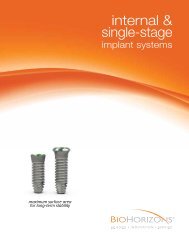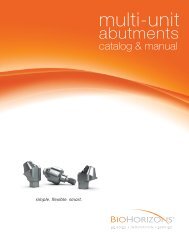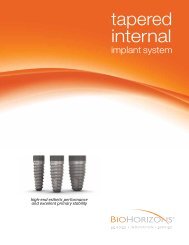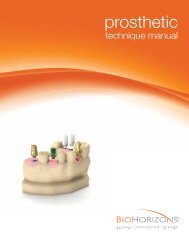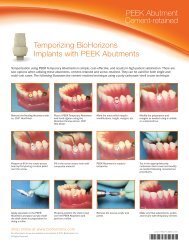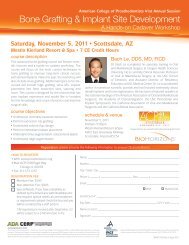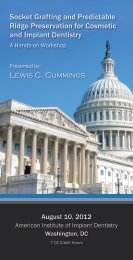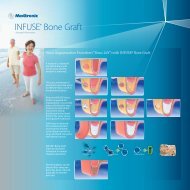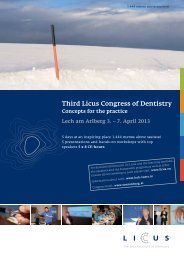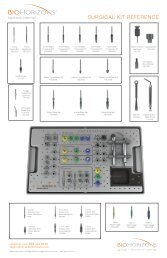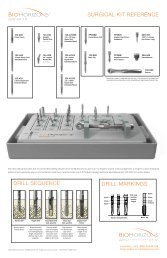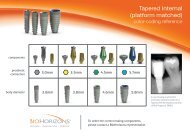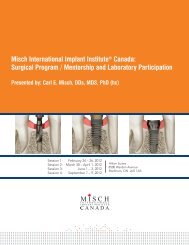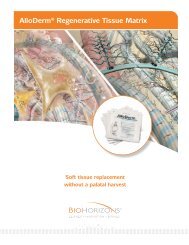External Dental Implant Catalog - BioHorizons
External Dental Implant Catalog - BioHorizons
External Dental Implant Catalog - BioHorizons
You also want an ePaper? Increase the reach of your titles
YUMPU automatically turns print PDFs into web optimized ePapers that Google loves.
Bone Profiler<br />
products products shown shown not to scale scale<br />
38<br />
ANCILLARY INSTRUMENTS<br />
Purpose: Remove and contour excess bone and soft tissue from the area of the prosthetic platform.<br />
• Compatible with latch-type, speed-reducing handpieces<br />
• 850-2,500 rpm drill speed with steady sterile irrigation9 • Cover Screw protects implant platform<br />
• Bone Profiler cuts away excess bone and soft tissue<br />
• Color-coded by specific prosthetic platform<br />
Bur Testing Gauge<br />
Surgical Kit Cleaning<br />
Do not use the Profiler without the Cover Screw in place.<br />
The Cover Screw aligns the Bone Profiler and protects the implant from damage. The Profiler is used in a latch-type, reduction<br />
handpiece under copious amounts of sterile irrigation. Following removal of the excess bone and soft tissue, unscrew the<br />
Cover Screw from the implant and seat the desired prosthetic element.<br />
Also called a “Go / No-Go Gauge,” the Bur Testing Gauge is used to verify the<br />
dimensional accuracy of drill shanks of latch-type burs. Burs in proper condition WILL<br />
fit into the larger diameter hole, but WILL NOT fit into the smaller hole (marked red).<br />
Burs that fail either of these criteria are unfit for use and may become stuck in the<br />
handpiece if used. The gauge is included with all W&H starter packages, and may also<br />
be ordered separately.<br />
All <strong>BioHorizons</strong> Surgical Kits are provided non-sterile and must be cleaned and sterilized prior to use following the associated<br />
Instructions for Use. Always remove instruments from packaging prior to sterilization, and remove and discard packaging<br />
materials used to stabilize and secure kits during shipment. Double-check all surgical instruments to ensure their functionality<br />
prior to surgery. Backup sterile drills are also recommended.<br />
Caution: The use of hydrogen peroxide or other oxidizing agents will cause damage to the surface of<br />
the instruments. Towel- or air-dry all instrumentation before sterilizing. Drills should be replaced after<br />
approximately 12 to 20 osteotomy cycles, depending on the bone density. 11<br />
Proper testing, cleaning and calibration of sterilization equipment should occur frequently to assure that the units are in proper<br />
working order. Equipment operating conditions vary and it is the responsibility of each dental office to ensure that the proper<br />
sterilization technique for instrumentation is followed.



